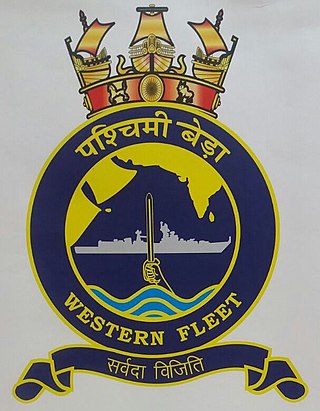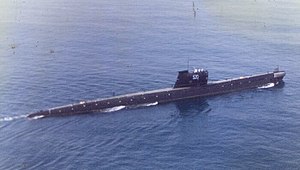
INSVikrant was a Majestic-class aircraft carrier of the Indian Navy. The ship was laid down as HMS Hercules for the British Royal Navy during World War II, but was put on hold when the war ended. India purchased the incomplete carrier in 1957, and construction was completed in 1961. Vikrant was commissioned as the first aircraft carrier of the Indian Navy and played a key role in enforcing the naval blockade of East Pakistan during the Indo-Pakistani War of 1971.

The Indian Navy (IN) is the maritime branch of the Indian Armed Forces. The President of India is the Supreme Commander of the Indian Navy. The Chief of Naval Staff, a four-star admiral, commands the navy. As a blue-water navy, it operates significantly in the Persian Gulf Region, the Horn of Africa, the Strait of Malacca, and routinely conducts anti-piracy operations and partners with other navies in the region. It also conducts routine two to three month-long deployments in the South and East China seas as well as the western Mediterranean sea simultaneously.

PNS/M Ghazi (S–130), SJ, was a Tench-class diesel-electric submarine, the first fast-attack submarine in the Pakistan Navy. She was leased from the United States Navy in 1963.
Operation Python, a follow-up to Operation Trident, was the code name of a naval attack launched on West Pakistan's port city of Karachi by the Indian Navy during the Indo-Pakistani War of 1971. After the first attack during Operation Trident on the Port of Karachi, Pakistan stepped up aerial surveillance of its coast as the presence of large Indian Navy ships gave the impression that another attack was being planned. Pakistani warships attempted to outsmart the Indian Navy by mingling with merchant shipping. To counter these moves, Operation Python was launched on the night of 8/9 December 1971. A strike group consisting of one missile boat and two frigates attacked the group of ships off the coast of Karachi. While India suffered no losses, Pakistani fleet tanker PNS Dacca was damaged beyond repair, and the Kemari Oil Storage facility was lost. Two other foreign ships stationed in Karachi were also sunk during the attack.

The Nilgiri-class frigates were updated versions of the Leander class, designed and built for the Indian Navy by Mazagon Dock Limited in Mumbai. Six ships were built between 1972–81. Vessels of the class formed the 14th Frigate Squadron. The lead ship INS Nilgiri was the first major warship to be built in India and was built in collaboration with Yarrow Shipbuilders of the United Kingdom.

The Abhay-class corvettes of the Indian Navy are the customised variants of the Soviet Pauk-class corvettes. The class was primarily intended for coastal patrol and anti-submarine warfare. Last ship of the class is expected to be decommissioned till 2025.

INS Nilgiri (F33) was the lead ship of her class of frigates. Commissioned on 3 June 1972 into the Indian Navy, she was decommissioned in 1996.
The Indo-Pakistani Naval War of 1971 refers to the maritime military engagements between the Indian Navy and the Pakistan Navy during the Indo-Pakistani War of 1971. The series of naval operations began with the Indian Navy's exertion of pressure on Pakistan from the Indian Ocean, while the Indian Army and Indian Air Force moved in to choke Pakistani forces operating in East Pakistan on land. Indian naval operations comprised naval interdiction, air defence, ground support, and logistics missions.
Arnala class was an Indian designation for the Petya III-class vessels of the Indian Navy.

INS Karanj (S23) is the third submarine of the first batch of six Kalvari-class submarines for the Indian Navy. It is a diesel-electric attack submarine based on the Scorpène class, designed by French naval defence and energy group DCNS and manufactured by Mazagon Dock Limited, an Indian shipyard in Mumbai. The submarine was launched on 31 January 2018, delivered to Indian Navy on 15 February 2021, commissioned on 10 March 2021 in Mumbai in presence of Chief of Naval Staff Admiral Karambir Singh and Admiral (Retired) VS Shekhawat.

The Western Fleet is a Naval fleet of the Indian Navy. It is known as the 'Sword Arm' of the Indian Navy. It is headquartered at Mumbai, Maharashtra on the west coast of India. It is a part of the Western Naval Command and is responsible for the naval forces in the Arabian Sea and parts of the Indian Ocean.

The Eastern Fleet is a Naval fleet of the Indian Navy. It is known as the 'Sword Arm' of the Eastern Naval Command and called the Sunrise Fleet. It is headquartered at Visakhapatnam, Andhra Pradesh on the east coast of India. It is a part of the Eastern Naval Command and is responsible for the naval forces in the Bay of Bengal and parts of the Indian Ocean.
Vice Admiral Elenjikal Chandy Kuruvila, PVSM, AVSM was a former Flag officer in the Indian Navy. He was the Fleet commander of the Western Fleet during the Indo-Pakistani War of 1971, for which he was awarded the Param Vishisht Seva Medal. He later led the Southern Naval Area and then served as the Chairman and Managing Director of Mazagon Dock Limited.
Rear Admiral Arun Auditto, AVSM, NM was a Flag Officer in the Indian Navy. He was decorated with a gallantry award during the Liberation of Goa. A pioneer submariner in the Indian Navy, he was the commissioning Commanding Officer of the Kalvari-class submarine INS Kursura (S20), which he commanded during the Indo-Pakistani War of 1971. He later commanded the submarine base INS Virbahu and the Whitby-class frigate INS Trishul (F143). After promotion to flag rank, he served as the Fortress Commander Andaman and Nicobar (FORTAN) and as the first Flag Officer Submarines, before retiring in 1988.

The Flag Officer Submarines (FOSM) is the single-point class authority of submarines in the Indian Navy. A two star Officer holding the rank of Rear Admiral, the FOSM is responsible for submarine safety, submarine training, maintenance and operating schedules and operational readiness inspections. The current FOSM is Rear Admiral K. Venkatraman who assumed office on 1 April 2023.

The Commodore Commanding Submarines (West) is an operational appointment in the Indian Navy. The COMCOS (W) is the commander of the all submarines and allied units of Western Naval Command. Based in Mumbai, Maharashtra, the COMCOS is also the Commanding Officer of the submarine base INS Vajrabahu. Currently, there are two COMCOS in the Indian Navy, COMCOS (East) and COMCOS (West). The COMCOS (W) is a one star officer holding the rank of Commodore. The current COMCOS (W) is Commodore Sriram Amur.


















